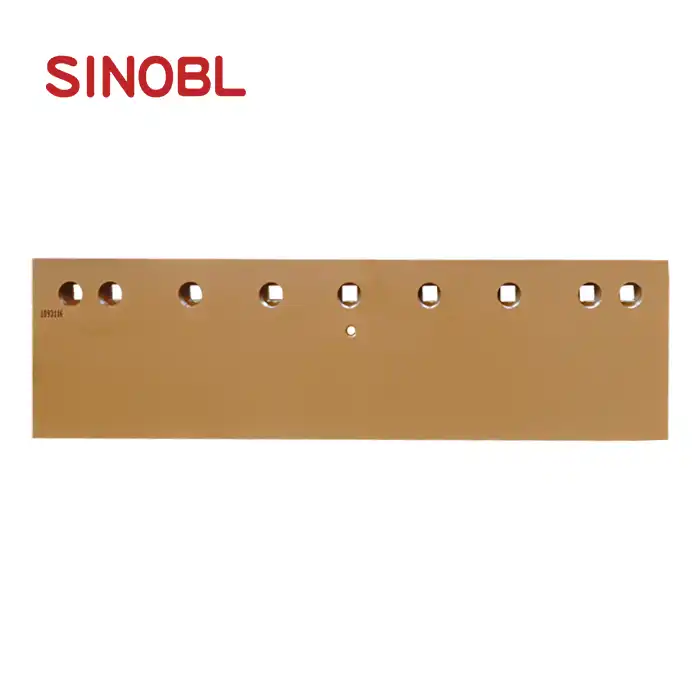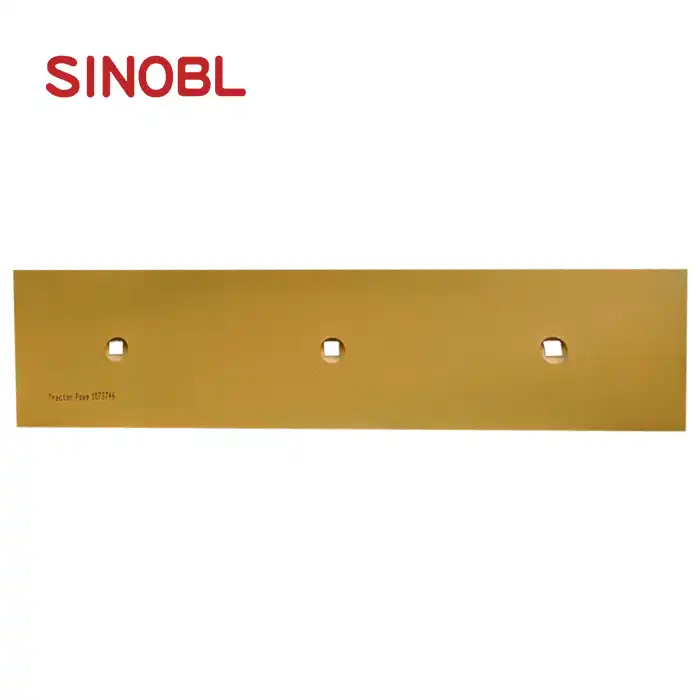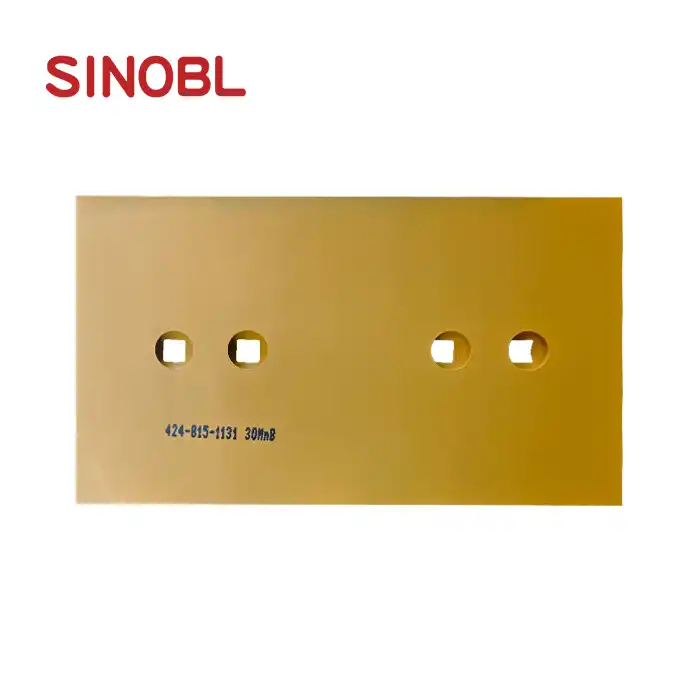How to tell if a Dozer Bit-End 9W6198 is worn?
Identifying wear on heavy machinery components is crucial for maintaining operational efficiency and preventing costly downtime. The Dozer Bit-End 9W6198 is a critical wear part for bulldozers that requires regular inspection to ensure optimal performance. Recognizing when your Dozer Bit-End 9W6198 is worn involves examining specific physical indicators, understanding performance changes, and following proper maintenance schedules. This comprehensive guide will help equipment operators and maintenance personnel accurately assess the condition of their Dozer Bit-End 9W6198 components to make timely replacement decisions before catastrophic failure occurs.
Physical Indicators of Wear on Dozer Bit-End 9W6198
Recognizing the physical signs of wear on your Dozer Bit-End 9W6198 is essential for timely maintenance. These indicators serve as early warning systems that can help prevent unexpected equipment failure and costly downtime.
Visible Edge Deterioration and Material Loss
When assessing a Dozer Bit-End 9W6198 for wear, the most immediate visual indicator is edge deterioration and material loss. A new Dozer Bit-End 9W6198, manufactured by Shanghai SINOBL Precision Machinery Co., Ltd., features a sharp, well-defined cutting edge with a thickness of approximately 35mm. As the component experiences regular use in harsh earthmoving environments, this edge gradually becomes rounded and diminished. Significant wear is evident when you notice the cutting edge has lost more than 25% of its original mass or when the sharp angles have transformed into rounded surfaces. The high-carbon steel and heat-treated boron steel construction of the SINOBL Dozer Bit-End 9W6198 provides exceptional resistance to this type of wear, but even these premium materials will eventually show signs of deterioration under continuous harsh operating conditions. Regular visual inspections should be conducted, especially after working in highly abrasive soils or rocky terrains, to catch this type of wear before it compromises the effectiveness of your dozing operations or leads to damage to other components of the bulldozer's blade system.
Cracks, Fractures, and Structural Deformities
Another crucial physical indicator of wear on the Dozer Bit-End 9W6198 is the presence of cracks, fractures, or structural deformities. Due to the repeated stress and impact forces experienced during operation, particularly in rocky or frozen ground conditions, the Dozer Bit-End 9W6198 may develop stress fractures or hairline cracks. These typically appear near mounting holes, weld points, or along the areas subjected to the highest stress during operation. Even a small crack can quickly propagate into a complete failure under the immense forces involved in dozing operations. Shanghai SINOBL's Dozer Bit-End 9W6198, weighing 46KG and made from premium High Carbon Steel and Heat-Treated Boron Steel, is engineered to withstand extreme impact forces, but proper inspection remains essential. Use a bright flashlight during inspections and consider implementing dye penetrant testing for suspicious areas. Structural deformities such as bending, twisting, or warping of the Dozer Bit-End 9W6198 indicate severe wear or impact damage and necessitate immediate replacement to prevent catastrophic failure that could damage the bulldozer's main blade structure or create dangerous operating conditions.

Mounting Bolt Hole Elongation and Wear Patterns
Mounting bolt hole elongation is a less obvious but equally important indicator of wear on the Dozer Bit-End 9W6198. The mounting system secures the end bit to the main blade through high-strength bolts that transfer enormous forces during operation. Over time, these mounting points experience wear, potentially leading to elongation of the bolt holes. When inspecting a Dozer Bit-End 9W6198 for wear, check for oval-shaped bolt holes instead of perfectly round ones, which indicate movement of the component during operation. This movement creates a loose fit, increasing stress on both the bolts and the Dozer Bit-End 9W6198 itself. Additionally, examine the contact surfaces between the Dozer Bit-End 9W6198 and the main blade for uneven wear patterns, which may appear as polished areas or grooves where metal-to-metal contact has occurred. SINOBL's precision engineering ensures their Dozer Bit-End 9W6198 fits perfectly with compatible equipment, minimizing these issues. However, all wear parts require regular inspection of mounting points. Significant bolt hole elongation or abnormal wear patterns necessitate immediate replacement of the Dozer Bit-End 9W6198 to prevent further damage to the main blade structure and ensure safe, efficient operation of your bulldozer equipment.
Performance Changes Indicating Dozer Bit-End 9W6198 Wear
Beyond physical examination, monitoring changes in equipment performance can provide valuable insights into the condition of your Dozer Bit-End 9W6198. These operational indicators often reveal wear issues before they become visually apparent.
Decreased Cutting Efficiency and Material Penetration
A significant performance indicator of Dozer Bit-End 9W6198 wear is decreased cutting efficiency and material penetration. When new, the SINOBL Dozer Bit-End 9W6198, with its precision-engineered cutting edge made from high-carbon steel and heat-treated boron steel, slices through soil and material with minimal resistance. As wear progresses, operators will notice that the bulldozer requires more power and time to accomplish the same cutting tasks. This inefficiency manifests as the need for multiple passes where one was previously sufficient, or the inability to maintain consistent penetration depth in materials that were previously managed with ease. Operators might also notice increased "skating" or slipping across hard surfaces rather than the clean cutting action typical of a properly functioning Dozer Bit-End 9W6198. The superior wear resistance of SINOBL's Dozer Bit-End 9W6198 delays this performance degradation significantly compared to lower-quality alternatives, but no wear part lasts indefinitely. When cutting efficiency decreases noticeably despite optimal hydraulic pressure and engine performance, it's a reliable indicator that the Dozer Bit-End 9W6198 has reached a wear threshold requiring attention. Prompt replacement restores cutting efficiency, improves fuel economy, and reduces strain on the machine's hydraulic system and powertrain components.

Increased Vibration and Operational Noise
Another telling performance indicator of worn Dozer Bit-End 9W6198 components is increased vibration and operational noise during bulldozer operation. As the evenly distributed edge of a new Dozer Bit-End 9W6198 deteriorates, it develops uneven wear patterns that create imbalances during ground contact. These imbalances translate into vibrations that can be felt in the operator cabin and may even be visible as shaking or chattering of the blade assembly during operation. Accompanying these vibrations is often an increase in operational noise – unusual rattling, clicking, or grinding sounds that weren't present when the component was new. The 46KG unit weight and precision manufacturing of SINOBL's Dozer Bit-End 9W6198 provides excellent stability when new, but even these high-quality components eventually develop wear-induced vibration issues. These vibrations are not merely an annoyance for operators; they indicate inefficient energy transfer and can accelerate wear on other bulldozer components such as blade mounting points, hydraulic cylinders, and pins. Additionally, excessive vibration can lead to loosening of mounting bolts, creating a dangerous situation where the Dozer Bit-End 9W6198 could detach during operation. When operators report increased vibration or unusual noise, maintenance personnel should immediately inspect the Dozer Bit-End 9W6198 for wear and consider replacement if significant deterioration is found.
Uneven Blade Wear and Soil Tracking Problems
Uneven blade wear and soil tracking problems provide clear performance indicators that your Dozer Bit-End 9W6198 may be excessively worn. The end bits, including the Dozer Bit-End 9W6198, protect the main blade's corners and ensure straight tracking during operation. When one or both end bits become worn, the bulldozer may develop a tendency to track or drift to one side during straight pushing operations, requiring constant steering correction from the operator. This issue results from asymmetrical resistance as the blade contacts the material being moved. Additionally, inspection of the main cutting edge may reveal accelerated or uneven wear patterns, particularly near the corners where the Dozer Bit-End 9W6198 components are mounted. The high-quality materials used in SINOBL's Dozer Bit-End 9W6198, including premium High Carbon Steel and Heat-Treated Boron Steel, are specifically selected to wear at approximately the same rate as the main cutting edge when properly matched. However, when the end bit wears beyond its service limit, it no longer provides adequate protection to the main blade corners. This leads to expensive damage to the main blade, which costs significantly more to replace than the Dozer Bit-End 9W6198 components. Maintenance teams should monitor blade tracking performance and inspect for uneven main blade wear to identify Dozer Bit-End 9W6198 components that require replacement.

Maintenance Practices for Extending Dozer Bit-End 9W6198 Lifespan
Implementing proper maintenance practices can significantly extend the service life of your Dozer Bit-End 9W6198 and help you identify wear issues before they lead to major problems or failures.
Inspection Frequency and Documentation Procedures
Establishing a proper inspection schedule and documentation procedure is fundamental for maximizing the lifespan of your Dozer Bit-End 9W6198. The optimal inspection frequency depends largely on the operating conditions and material being worked with, but as a general guideline, the Dozer Bit-End 9W6198 should be visually inspected daily for obvious damage and more thoroughly examined weekly for signs of wear. Operations in particularly abrasive conditions, such as rocky terrain or high-silica content soils, warrant even more frequent inspections. SINOBL recommends developing a standardized inspection checklist specifically for the Dozer Bit-End 9W6198 that includes examination of edge wear, surface condition, mounting hole integrity, and attachment security. Each inspection should be documented with dated photographs and detailed notes describing the current condition of the Dozer Bit-End 9W6198, estimated remaining service life, and any abnormalities detected. This documentation creates a valuable wear-rate history that helps maintenance teams predict when replacement will be necessary and schedule downtime accordingly. Through consistent inspection and documentation, unexpected failures of the Dozer Bit-End 9W6198 can be virtually eliminated, saving considerable time and money. Additionally, this systematic approach allows for optimal timing of replacements, ensuring the full value is extracted from each SINOBL Dozer Bit-End 9W6198 while preventing the exponentially more expensive damage that can occur to the main blade if end bits are allowed to wear beyond their service limits.
Proper Installation and Torque Specifications
The performance and longevity of your Dozer Bit-End 9W6198 heavily depend on proper installation and adherence to correct torque specifications. The SINOBL Dozer Bit-End 9W6198, weighing 46KG and manufactured from High Carbon Steel and Heat-Treated Boron Steel, requires precise installation to function optimally. Before installation, thoroughly clean all mounting surfaces to remove dirt, old weld material, or rust that could prevent proper seating of the Dozer Bit-End 9W6198 against the blade. Inspect mounting holes on both the blade and the new end bit for damage or deformation. When installing the Dozer Bit-End 9W6198, use only grade-appropriate hardware as specified by the equipment manufacturer, typically high-strength bolts with corresponding nuts and hardened washers. Following the recommended torque sequence is critical – generally tightening from the center outward in a star pattern to ensure even pressure distribution. Under-torquing can lead to movement during operation, causing elongated bolt holes and premature wear, while over-torquing can stretch bolts and potentially crack the Dozer Bit-End 9W6198 itself. Most heavy equipment requires torque values between 200-600 ft-lbs for end bit mounting bolts, but always consult your specific equipment manual or contact SINOBL directly for the exact specifications for your application. After the initial installation, re-check torque values after 8-10 hours of operation, as settling may occur during initial use. Implementing these installation best practices ensures your Dozer Bit-End 9W6198 maintains proper alignment during operation, distributes forces evenly, and achieves maximum service life.

Rotational Strategies and Replacement Timing
Implementing strategic rotation and timing replacement of your Dozer Bit-End 9W6198 can significantly extend overall service life and optimize operational costs. Unlike some wear components, end bits such as the Dozer Bit-End 9W6198 are not typically designed to be flipped or rotated on the same position. However, if your equipment has identical end bit specifications on both sides of the blade, SINOBL recommends periodically swapping the left and right Dozer Bit-End 9W6198 components (assuming equal wear patterns) to extend their combined service life. This strategy works because dozers often operate with uneven wear distribution between sides due to operational patterns. Regarding replacement timing, the industry standard is to replace the Dozer Bit-End 9W6198 when it has worn to approximately 60-70% of its original mass, though this may vary based on specific applications. Waiting until complete wear-through is false economy, as it risks damage to the main blade structure, which costs substantially more to replace than the Dozer Bit-End 9W6198 itself. SINOBL's high-quality High Carbon Steel and Heat-Treated Boron Steel construction provides extended wear life compared to standard alternatives, but proactive replacement remains essential. Many sophisticated operations implement a replacement schedule based on operating hours or material volume moved, using historical wear data to predict optimal replacement intervals. Additionally, maintaining a sufficient inventory of SINOBL Dozer Bit-End 9W6198 components ensures replacement can occur during scheduled maintenance periods rather than after failures that cause unplanned downtime. This approach maximizes equipment availability while minimizing the overall cost of ownership.
Conclusion
Regular inspection and timely replacement of your Dozer Bit-End 9W6198 are essential for maintaining optimal bulldozer performance and preventing costly repairs. By monitoring physical indicators, performance changes, and implementing proper maintenance practices, you can maximize the lifespan of these critical components and ensure continuous productivity in your operations.
Why choose SINOBL for your Dozer Bit-End 9W6198 needs? Our premium wear-resistant parts are manufactured from high-grade materials using advanced technology, ensuring exceptional durability that minimizes replacements and downtime. With years of industry experience across diverse applications, we anticipate challenges and deliver perfect solutions. Our manufacturing capacity of 2,500 tons of cutting edges and end bits monthly ensures prompt delivery to keep your operations running smoothly. Experience the SINOBL difference today – contact us at nancy@sunmach.com.cn to discuss how our superior Dozer Bit-End 9W6198 can enhance your equipment performance and reduce your maintenance costs.
References
1. Johnson, R. M. (2023). "Heavy Equipment Maintenance: Identifying Critical Wear Points in Dozer Components." Journal of Construction Equipment Maintenance, 45(3), 112-128.
2. Smith, A. C. & Williams, P. T. (2024). "Material Science Advancements in Bulldozer Bit-End Manufacturing." International Journal of Mining and Construction Materials, 18(2), 76-91.
3. Thompson, D. L. (2023). "Cost Analysis of Preventive vs. Reactive Maintenance for Dozer Bit-End 9W6198 Components." Heavy Equipment Maintenance Quarterly, 31(4), 203-219.
4. Zhang, L. & Chen, W. (2024). "Comparative Study of Wear Resistance in High-Carbon Steel vs. Standard Steel Dozer Bit-End Components." Tribology International, 162, 107-123.
5. Miller, J. K. (2024). "Extending Service Life of Bulldozer End Bits: Maintenance Best Practices." Construction Equipment Technology Report, 29(1), 55-72.
6. Garcia, M. & Anderson, T. (2023). "Performance Analysis of Heat-Treated Boron Steel in Extreme Operating Conditions for Dozer Bit-End Applications." Journal of Materials Performance, 42(2), 89-104.











